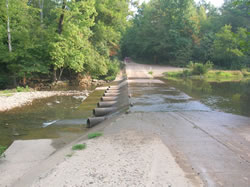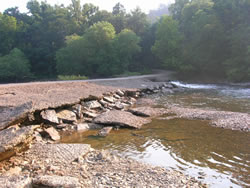Aquatic Organism Passage Program Success Story
Ouachita National Forest Aquatic Organism Passage Restoration and Stream Habitat Stabilization (2008)
Objective and Purpose of the Project
Restore aquatic organism passage (primarily fish) at selected road crossings and determine additional high priority crossing replacements across the Forest.
Methods or Techniques Used
Collaborative work between the Forest Fisheries Biologist, District Biologists and the Forest's Engineering staff resulted in contracts for the replacement of two failing road crossings that are aquatic organism passage-friendly. An additional crossing to replace a natural bottom stream crossing that is causing sedimentation problems was designed but not awarded due to “fire borrowing”, which froze the available funding during Fiscal Year 2008. Approximately 30 miles of a user-created ATV trail was closed and put-to-bed that reduced sediment loading of approximately 35 miles of streams. A team from the Forest Service’s Center for Aquatic Technology Transfer, checked for fish passage at approximately 100 stream crossings with the data and reports to be sent to the forest during early Fiscal Year 2009. Approximately three stream crossings were schedule for remedial work to retrofit fish passage however the work was stopped by fire borrowing of the funds.
Realized and Expected Results

Low water crossing on Little Missouri River.

Little Missouri River replacement bridge for passage.

Forest Service Road 53000 Glover River crossing and barrier.
Eleven miles of improved fish passage and thirty-four miles of stabilized stream habitats resulted from this year’s work, but work on seven miles of improved fish passage and one mile of stabilized stream habitat work was halted by fire borrowing. The replacement crossing on Forest Road 53000 crosses the Glover River which is Critical Habitat for the Federally-listed Threatened leopard darter. This work required a Biological Opinion for the U.S. Fish and Wildlife Service and a 401/404 Permit from the Oklahoma Department of Environmental Quality and the Army Corps of Engineers respectively which was handled by the Forest Fisheries Biologist.
The contract for the Glover River low-water bridge was partially funded with a U.S. Fish and Wildlife Service fish passage grant ($60,000) received in FY 2006 for this particular project and most of the funding was through the U.S. Department of Transportation's grant to the Forest Service for fish passage restoration under Safe Accountable, Flexible, Efficient Transportation Equity Act: A Legacy for Users (SAFETEA-LU) funding.
A graduate student has started working on a research project examining fish passage at new box culvert structures and is also field testing a prototype piece of equipment for monitoring fish passage in cooperation with the San Dimas Technology and Development Center. This study was primarily funded internal FS engineering funds (CMRD funding) to examine fish passage at two crossings replaced with these funds but the development and on-going administration of the project was done with Forest Service wildlife and fisheries funds (NFWF funding).
Partners
Partners associated with this project included Arkansas Tech University, Center for Aquatic Technology Transfer, San Dimas Technology and Development Center, USDI Fish and Wildlife Service - Oklahoma, and U.S. Department of Transportation, Federal Highway Administration.

